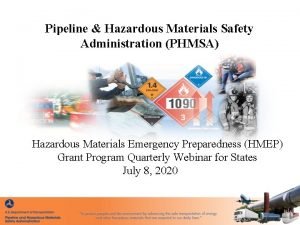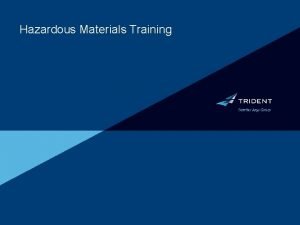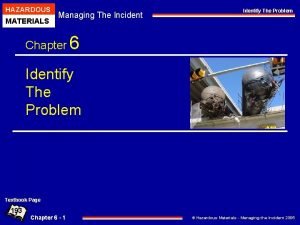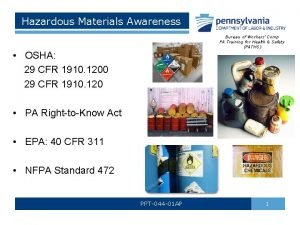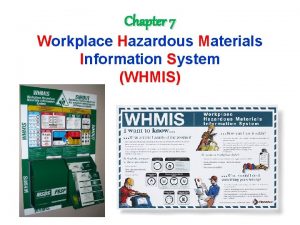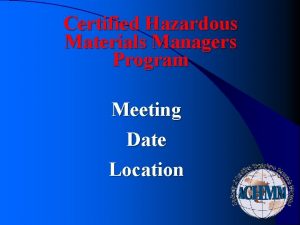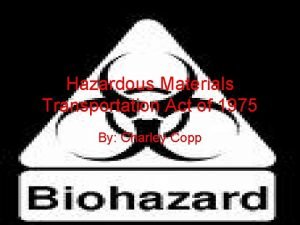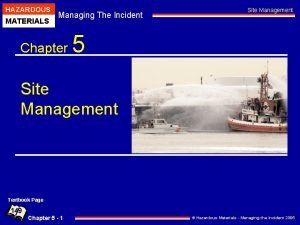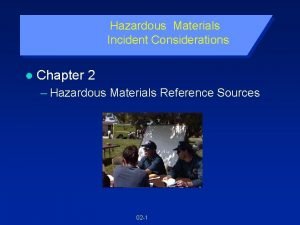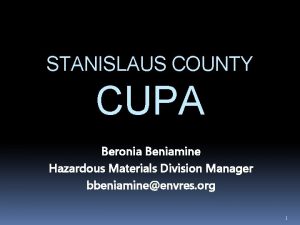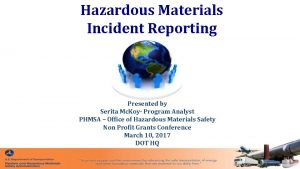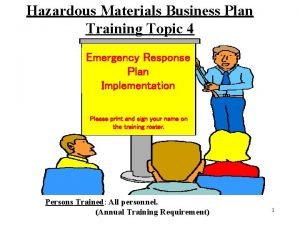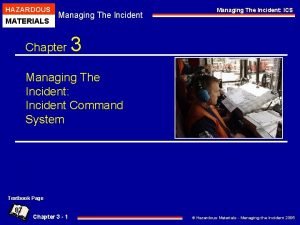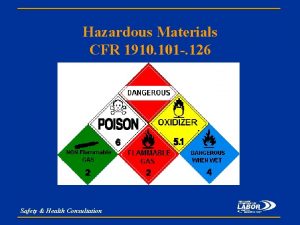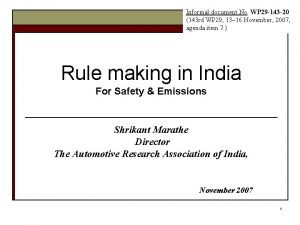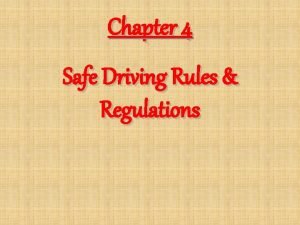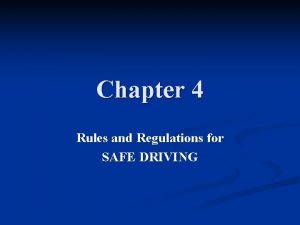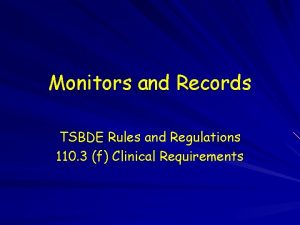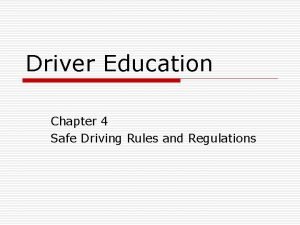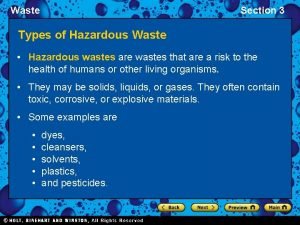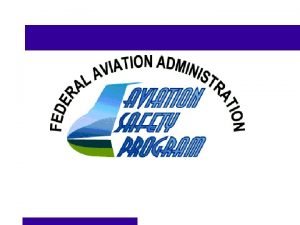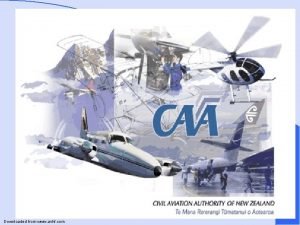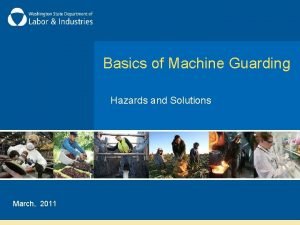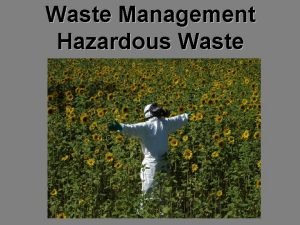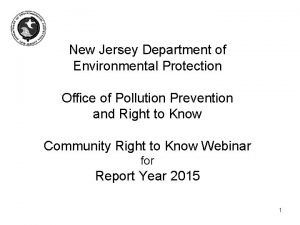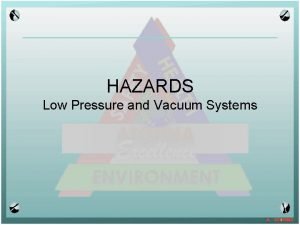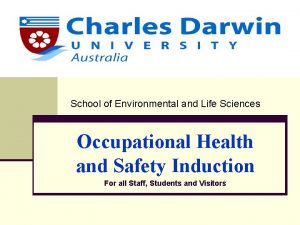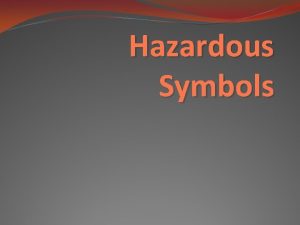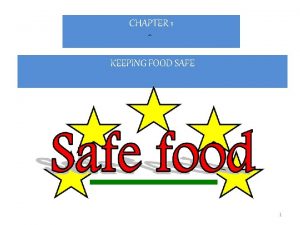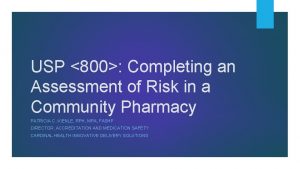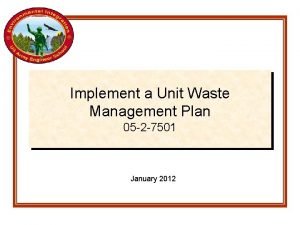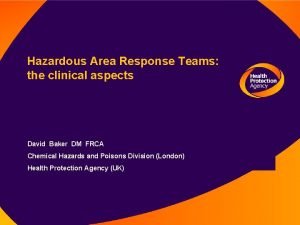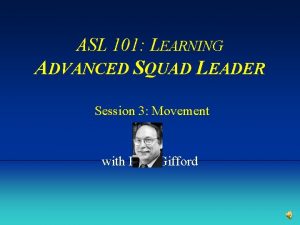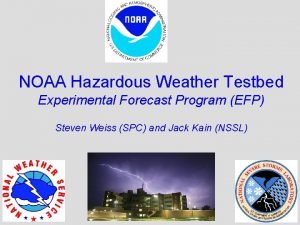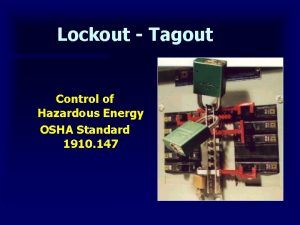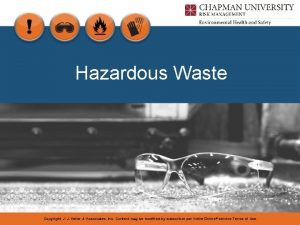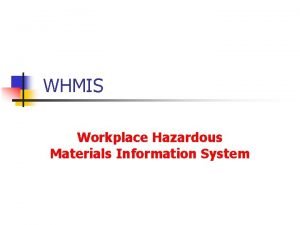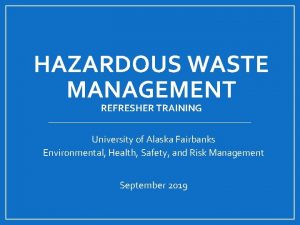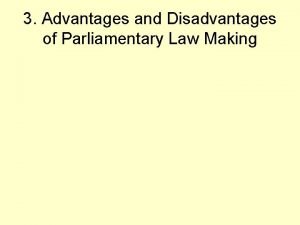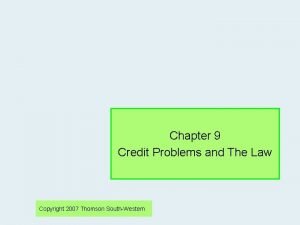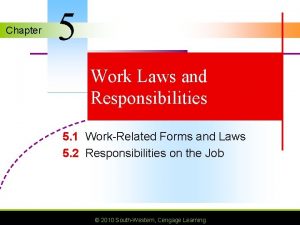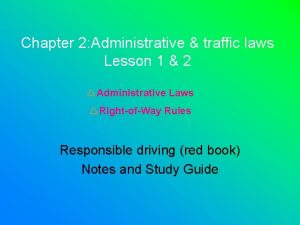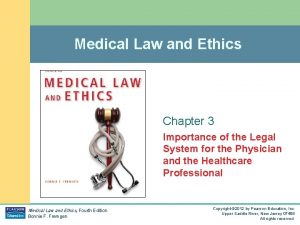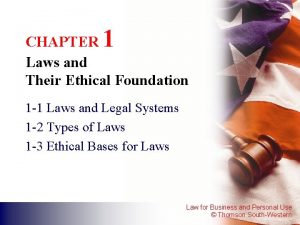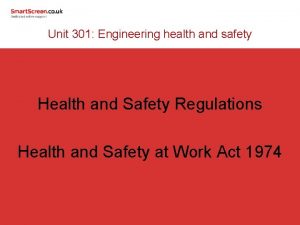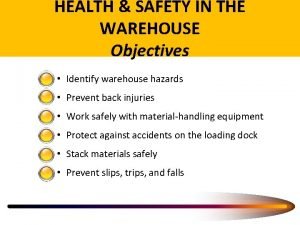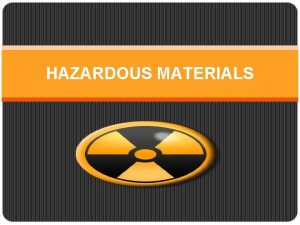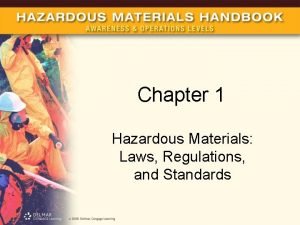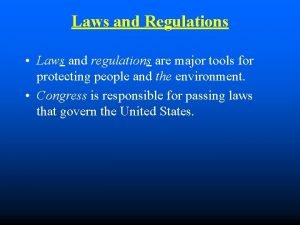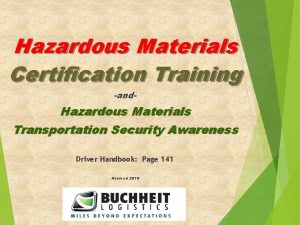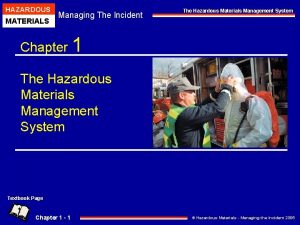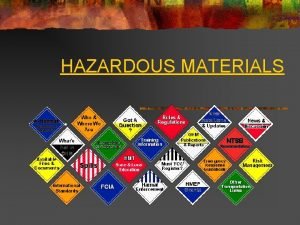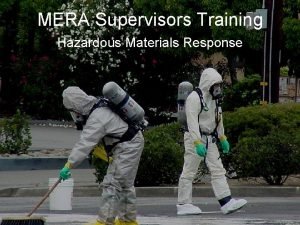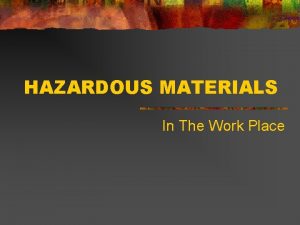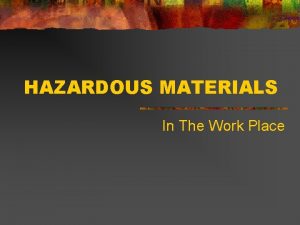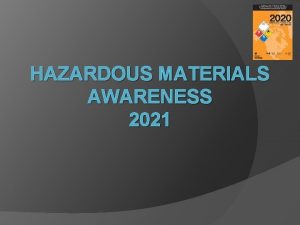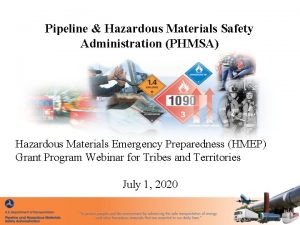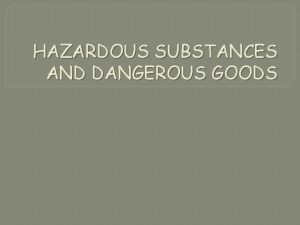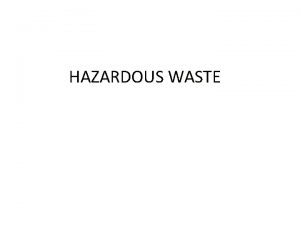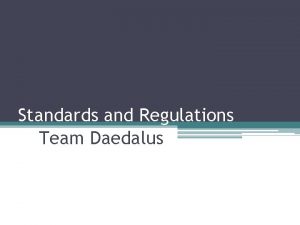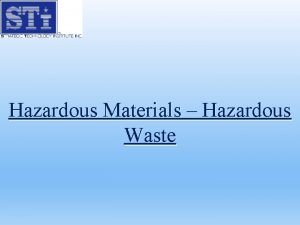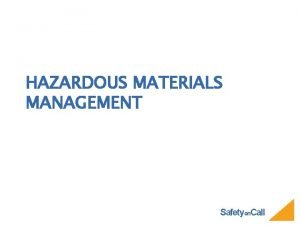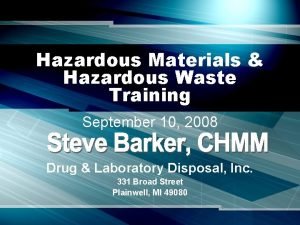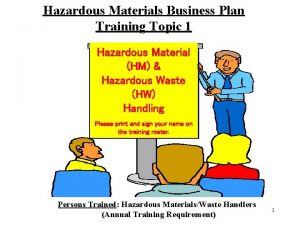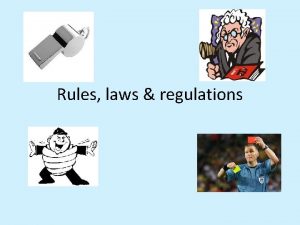Chapter 29 Hazardous Materials Regulations Standards and Laws










































































- Slides: 74

Chapter 29 Hazardous Materials Regulations, Standards, and Laws

Objectives: Awareness Level • Define the terms hazardous materials (or dangerous goods, in Canada) and weapons of mass destruction. • Identify the difference between hazardous materials/WMD incidents and other emergencies. • Identify the location of both the emergency response plan and standard operating procedures.

Objectives: Awareness Level • Understand the difference(s) between the standards and federal regulations that govern hazardous material response activities. • Describe the different levels of hazardous materials training: awareness, operations, technician, specialist, and incident commander. • Explain the need for a planned response to a hazardous materials incident.

Introduction • Emergency responders may include – Firefighters – Law enforcement personnel – Emergency medical services (EMS)

Introduction • Types of incidents – Structural fires – Emergency medical calls – Automobile accidents – Confined-space rescues – Water rescues – Acts of terrorism

Introduction • Emergency situations may involve hazardous substances that threaten – Lives – Property – Environment

Introduction • Nature of the incident and mentality of the responder changes when the presence of hazardous materials is suspected Courtesy of George Roarty/VDEM.

Introduction • Hazardous incidents are handled in a more deliberate fashion. – Could be unknown substances present – Setting may make it difficult to get a full picture of the incident – Often takes responders more time to get oriented to the problem and define a rational approach

Introduction • Factors dictating the actions taken at hazardous materials/WMD incidents: – Chemicals or hazards involved – Environmental influences – How chemicals behave during the release

Introduction • Personnel must be conscious of the potential or actual law enforcement aspect. – Be mindful of evidentiary issues. – Be cognizant of the impact your presence will have on potential evidence.

Introduction • Make a conscious effort to change your perspective when responding to hazardous materials/WMD incidents. – Slow down. – Think about the problem and available resources. – Take well-considered actions to solve it.

Introduction • Initial and ongoing actions may be guided by: – Your authority having jurisdiction (AHJ) – Local or organizational emergency response plans – Standard operating procedures (SOPs)

Introduction • Sections 3, 4, and 5 of this book will help you learn how to – Recognize the presence of a hazardous materials/WMD incident. – Take initial actions. – Use basic reference sources. – Select personal protective clothing. – Implement product control measures when needed. – Perform appropriate decontamination. – Understand where you fit into a full-scale hazardous materials/WMD response.

What Is a Hazardous Material Anyway? • Hazardous material – Substance capable of posing unreasonable risk to human health, safety, or environment when • Transported in commerce • Used incorrectly • Not properly contained or stored – Referred to as dangerous goods in UN Model Regulations

Weapons of Mass Destruction • Defined by the United States Code as: – Destructive device, such as explosive, incendiary, or poison gas bomb, grenade, rocket having a propellant charge of more than 4 oz (113 g), missile having an explosive or incendiary charge of more than 0. 25 oz (7 g), mine, or similar device – Weapon involving toxic or poisonous chemicals – Weapon involving a disease organism – Weapon designed to release radiation or radioactivity at a level dangerous to human life

Weapons of Mass Destruction • Also known as CBRNE – Chemical – Biological – Radiological – Nuclear – Explosive

Hazardous Materials Can Be Almost Anything • Almost anything can be a hazardous substance, depending on the situation. • No jurisdiction is immune to deliberate criminal acts. Courtesy of Rob Schnepp.

Hazardous Wastes • Unpure substances that remain after a manufacturing process has used a substance • Can be just as dangerous as pure chemicals • May comprise mixtures of several chemicals – Can make it difficult to determine how the substance will react when released or if it encounters other chemicals

Levels of Training: Regulations and Standards • Regulations – Issued and enforced by governmental bodies • Standards – Issued by nongovernmental entities – Generally consensus-based – May be voluntary

Levels of Training: Regulations and Standards • National Fire Protection Association (NFPA) – Issues voluntary consensus-based standards – Technical committee is required to • Meet regularly • Revise, update, and possibly change a standard • Review and act on any public comments during the revision process – Once finalized, agencies may choose to adopt the standard.

State-Plan and Non-State-Plan States • State-plan states – Opt to adopt Occupational Safety and Health Administration (OSHA) regulations – Includes about half of the states

State-Plan and Non-State-Plan States • Non-plan states – Have not adopted OSHA regulations – Considered EPA states because they follow Title 40 of the CFR, Protection of the Environment, Part 311, Worker Protection

NFPA Standards and OSHA Regulations • Technical Committee on Hazardous Materials Response Personnel – Responsible for NFPA standards governing hazardous materials/WMD – Published standards important to responders • NFPA 472 • NFPA 1072 • NFPA 473

NFPA Standards and OSHA Regulations • NFPA 1072 applies to the following levels: – Awareness – Operations – Mission-specific operations – Hazardous materials technician – Incident commander

NFPA Standards and OSHA Regulations • NFPA 473 contains mission-specific competencies, including: – Advanced life support (ALS) responder assigned to a hazardous materials team – ALS responder to provide interventions at a hazardous materials/WMD incident – ALS responder to treat smoke inhalation victims

NFPA Standards and OSHA Regulations • NFPA 475 – Establishes common criteria for the organization, management, programmatic elements, deployment of personnel, and resources for those entities responsible for the hazardous materials/WMD emergency preparedness function

NFPA Standards and OSHA Regulations • OSHA HAZWOPER – Stands for HAZardous Waste OPerations and Emergency Response – Training levels include • Awareness • Operations • Technician • Specialist • Incident commander

NFPA Standards and OSHA Regulations • NFPA 472 is updated every five years. • NFPA 472 and HAZWOPER are not “how to respond” documents. – Provide guidance on competencies associated with the various training levels • NFPA 1072 is intended to identify the job performance requirements (JPRs) that personnel should be able to perform.

Awareness Level (NFPA) • NFPA 1072 Section 4. 1. 1 defines awareness level personnel: – Persons who could encounter an emergency involving hazardous materials/WMD and who are expected to recognize the presence of the hazardous materials/WMD, protect themselves, call for trained personnel, and secure the area Reproduced with permission from NFPA 1072, Standard for Hazardous Materials/Weapons of Mass Destruction Emergency Response Personnel Professional Qualifications , Copyright© 2017, National Fire Protection Association. This reprinted material is not the complete and official position of the NFPA on the referenced subject, which is represented only by the standard in its entirety.

Awareness Level (NFPA) • NFPA 472 states that a person with awareness level training is not considered a responder. – Now referred to as awareness level personnel – Not typically called to the scene to respond – Function in support roles

Awareness Level (NFPA) • Tasks awareness level personnel may be expected to perform on the scene: – Analyzing the incident – Identifying distinctive markings – Collecting information from the current edition of the Emergency Response Guidebook (ERG) – Initiating and implementing protective actions – Initiating the notification process • Awareness level personnel must meet the requirements defined in NFPA 1072, Chapter 4.

Awareness Level (OSHA) • OSHA HAZWOPER – Designates awareness level personnel as responders – States that first responders at the awareness level are likely to witness or discover a hazardous substance release and that they have been trained to initiate a response sequence by notifying the proper authorities of the release. They would take no further action beyond notifying the authorities.

Awareness Level (OSHA) • Awareness level responder competencies – Understanding what hazardous substances are and the risks associated with them – Understanding the potential outcomes of an incident – Recognizing the presence of hazardous substances – Identifying hazardous substances, if possible

Awareness Level (OSHA) • Awareness level responder competencies – Understanding the role of the first responder awareness individual in the response plan – Determining the need for additional resources and notifying the communication center

Operations Level (NFPA) • According to NFPA 1072, operations level responders are – Tasked to respond to hazardous materials/WMD incidents to take action to protect nearby persons, the environment, or property from the effects of the release

Operations Level (NFPA) • Operations level responders may also have competencies specific to their – Response mission – Expected tasks – Equipment and training

Operations Level (NFPA) • Operations level core competencies – Analyzing the scene to determine the scope of the incident – Surveying scene to identify containers and materials involved – Collecting information from available reference sources – Predicting likely behavior of a hazardous material

Operations Level (NFPA) • Operations level core competencies – Estimating potential harm substances might cause – Planning a response to the release – Performing decontamination – Preserving evidence – Evaluating response status and effectiveness

Operations Level (NFPA) • Core competency training is required of all operations level responders on the scene. • One goal of NFPA 472 is to better match expected tasks with the training the responder should receive.

Operations Level (NFPA) • Responders expected to perform additional missions beyond the core competencies must be trained to carry out those mission-specific responsibilities. • NFPA 472 and NFPA 1072 provide a mechanism to ensure that operations level responders do not go beyond their level of training and equipment.

Operations Level (NFPA) • NFPA 1072 defines mission-specific competencies as – The knowledge, skills, and judgment needed by operations level responders who have completed the operations level competencies and who are designated by AHJ to perform mission-specific tasks, such as decontamination, victim/hostage rescue and recovery, evidence preservation, and sampling

Operations Level (NFPA) • Mission-specific competencies include – Personal protective equipment (PPE) – Mass decontamination – Technical decontamination – Evidence preservation and public safety sampling – Product control – Detection, monitoring, and sampling – Victim rescue/recovery

Operations Level (NFPA) • Mission-specific competencies – Illicit laboratory incidents – Disablement/disruption of improvised explosive devices (IEDs), improvised WMD dispersal devices, and operations at improvised explosives laboratories – Diving in contaminated water environment – Evidence collection

Operations Level (OSHA) • OSHA HAZWOPER mandates that operations level responders must be trained to respond defensively: – Without trying to stop the release directly – While avoiding contact with the released substance Courtesy of Rob Schnepp.

Operations Level (OSHA) • Their function is to – Contain the release from a safe distance – Keep it from spreading – Prevent or reduce the potential for human exposures

Operations Level (OSHA) • Operations level responder competency areas – Knowing the basic hazard and risk assessment techniques – Knowing how to select and use proper PPE provided – Understanding basic hazardous materials terms

Operations Level (OSHA) • Operations level responder competency areas – Knowing how to perform basic control, containment, and/or confinement operations within the capabilities of the resources and PPE available with their unit – Knowing how to implement basic decontamination procedures – Understanding relevant SOPs and termination procedures

Technician/Specialist Level (NFPA) • NFPA 1072 defines technician level personnel as – Persons who respond to hazardous materials/WMD incidents using a risk-based response process by which they analyze a problem involving hazardous materials/WMD, plan a response to the problem, implement the planned response, evaluate progress of the planned response, and assist in terminating the incident.

Technician/Specialist Level (NFPA) • Hazardous materials technicians use a riskbased response process with the ability to: – Analyze a problem involving hazardous materials/WMD – Select appropriate decontamination procedures – Control a release using specialized protective clothing and control equipment

Technician/Specialist Level (NFPA) • Hazardous materials technicians should also have additional competencies specific to their – Response mission – Expected tasks – Equipment and training

Technician/Specialist Level (NFPA) • Technician level personnel – Often supervise activities of on-scene operations level responders – Act to stop the release – Commonly assume a more proactive role than an operations level responder – Typically function at a higher level in terms of their cognitive approach to the response

Technician/Specialist Level (OSHA) • OSHA HAZWOPER states that hazardous materials technicians should receive at least 24 hours of training equal to the first responder operations level Courtesy of Rob Schnepp.

Technician/Specialist Level (OSHA) • Technician level responder competencies – Implement employer’s emergency response plan – Classify, identify, and verify known and unknown materials by using field survey instruments and equipment – Function within an assigned role in the Incident command sysem (ICS) – Select and use proper specialized chemical PPE – Understand hazard and risk assessment techniques

Technician/Specialist Level (OSHA) • Technician level responder competencies Perform advanced control, containment, and/or confinement operations within the capabilities of the resources and PPE available with the unit – Understand implement decontamination procedures – Understand termination procedures – Understand basic chemical and toxicological terminology and behavior

Technician/Specialist Level (OSHA) • Specialist level – Identified only in the OSHA HAZWOPER standard – Receives more specialized training than hazardous materials technicians

Incident Commander • NFPA 1072 states that the incident commander (IC) is the person responsible for all incident activities, including – Developing strategies and tactics – Ordering and releasing resources

Incident Commander • IC must receive additional training to meet – Governmental occupational health and safety regulations – Specific needs of the jurisdiction • ICs should have – Operations level training – Additional training specific to commanding a hazardous materials incident

Incident Commander • Incident commander competency areas – Know and implement employer’s ICS. – Know how to implement employer’s emergency response plan. – Know and understand hazards and risks associated with chemical protective clothing.

Incident Commander • Incident commander competency areas – Know how to implement the local emergency response plan. – Know of the state emergency response plan and of the Federal Regional Response Team. – Know and understand the importance of decontamination procedure.

Incident Commander • OSHA regulations require annual refresher training of sufficient content and duration to ensure that responders maintain their competencies or that they demonstrate competency in those areas at least yearly.

Other Governmental Agencies • Other governmental agencies concerned with various aspects of hazardous materials/WMD response include – Department of Transportation (DOT) – Environmental Protection Agency (EPA) – Local emergency planning committees (LEPCs) – State Emergency Response Commissions (SERCs)

Preplanning • The response to an incident begins with – Initial training – Continuing education – Preplanning activities at target hazards and other potential problem areas

Preplanning • Target hazards include any occupancy type or facility that presents – A high potential for loss of life – Serious impact to the community resulting from fire, explosion, or chemical release

Preplanning • Preplanning activities enable agencies to develop logical and appropriate response procedures for anticipated incidents. – Planning should focus on real threats. © Jones & Bartlett Learning. Photographed by Glen E. Ellman.

Preplanning • Preplanning at major target hazards should include discussions and information-sharing with the LEPC. • Once threats have been identified, fire departments, police agencies, public health offices, and other governmental agencies should: – Determine the most appropriate response – Work together in case of a large-scale incident.

Preplanning • Moving toward interoperability before an incident often makes the actual response work run smoothly.

Summary • When an incident clearly involves a hazardous material, or you suspect the presence of a release, the nature of the incident changes and so must the mentality of the responder. • A hazardous material is any substance or material that can pose an unreasonable risk to human health, safety, or the environment.

Summary • OSHA and the EPA issue and enforce regulations concerning hazardous materials emergencies. • Consensus-based NFPA standards relating to hazardous materials/WMD are available for those agencies that choose to adopt them.

Summary • Three NFPA standards are important to responders: – NFPA 472, Standard for Competence of Responders to Hazardous Materials/Weapons of Mass Destruction Incidents – NFPA 1072, Standard for Hazardous Materials/Weapons of Mass Destruction Emergency Response Personnel Professional Qualifications – NFPA 473, Standard for Competencies for EMS Personnel Responding to Hazardous Materials/Weapons of Mass Destruction Incidents

Summary • The OSHA HAZWOPER regulation is found in the CFR, Title 29, Standard 1910. 120(q). • The EPA’s version of OSHA’s HAZWOPER can be found in the CFR, Title 40, Protection of the Environment, Part 311: Worker Protection.

Summary • The goals associated with the competencies of awareness level personnel are to recognize a potential hazardous materials emergency, to isolate the area, and to call for assistance. Awareness level personnel take protective actions only.

Summary • NFPA 472 expands the scope of an operations level responder’s duties by making a distinction between core competencies and mission-specific competencies.

Summary • For those who choose to adopt the NFPA 472 standard, the core competencies are required for all operations level responders; each agency can then pick and choose to require any or all of the mission-specific responsibilities. The core competencies of operations level responders are defensive actions.

Summary • Hazardous materials technicians will control a hazardous materials release using specialized protective clothing and control equipment. • The hazardous materials incident commander is responsible for all incident activities.
 Pipeline and hazardous materials administration
Pipeline and hazardous materials administration Dot
Dot Hazardous materials table
Hazardous materials table Us military marking system for hazardous materials
Us military marking system for hazardous materials Hazwoper
Hazwoper Shape and color of whmis 2015 symbols
Shape and color of whmis 2015 symbols Certified hazardous materials manager
Certified hazardous materials manager Hazardous materials transportation act of 1975
Hazardous materials transportation act of 1975 Hazardous materials managing the incident
Hazardous materials managing the incident Hazardous materials reference books
Hazardous materials reference books Stanislaus county hazardous waste
Stanislaus county hazardous waste Hazardous materials incident report
Hazardous materials incident report Hazardous materials business plan
Hazardous materials business plan Hazardous materials managing the incident
Hazardous materials managing the incident Osha psm 1910
Osha psm 1910 Food laws and regulations in pakistan pdf
Food laws and regulations in pakistan pdf Why do we have hunting laws
Why do we have hunting laws Automotive regulations and standards
Automotive regulations and standards Food safety regulations and standards
Food safety regulations and standards Charles de secondat
Charles de secondat Go noodle cant stop the feeling
Go noodle cant stop the feeling Useful harmful
Useful harmful Natural man made
Natural man made Differentiate adopting materials and adapting materials
Differentiate adopting materials and adapting materials Motorist
Motorist Chapter 4 safe driving rules and regulations
Chapter 4 safe driving rules and regulations Chapter 4 safe driving rules and regulations
Chapter 4 safe driving rules and regulations Head tilt chin lift and jaw thrust maneuver is used for
Head tilt chin lift and jaw thrust maneuver is used for Chapter 4 safe driving rules and regulations
Chapter 4 safe driving rules and regulations Factors necessary for appropriate service standards
Factors necessary for appropriate service standards Solid and hazardous waste
Solid and hazardous waste Direct materials budget with multiple materials
Direct materials budget with multiple materials Section 3 hazardous waste answers
Section 3 hazardous waste answers Aviation hazardous attitudes
Aviation hazardous attitudes Definition of biomedical waste management
Definition of biomedical waste management Avhf
Avhf Hazardous attitudes
Hazardous attitudes Hazardous mechanical motion
Hazardous mechanical motion E-waste definition apes
E-waste definition apes Example of hazardous waste
Example of hazardous waste Nj crtk environmental hazardous substances
Nj crtk environmental hazardous substances Low pressure hazardous vacuum switch
Low pressure hazardous vacuum switch Hazardous area training darwin
Hazardous area training darwin Hazardous symbols
Hazardous symbols Potentially hazardous food is usually moist
Potentially hazardous food is usually moist Hazardous drug api
Hazardous drug api On july 18 2001 a train carrying hazardous chemicals
On july 18 2001 a train carrying hazardous chemicals Waste management references
Waste management references Hazardous area response team
Hazardous area response team Hazardous movement asl
Hazardous movement asl Hazardous weather testbed
Hazardous weather testbed Hazardous energy
Hazardous energy Hazardous waste transportation
Hazardous waste transportation Whmis r with test tube
Whmis r with test tube Hazmat training alaska
Hazmat training alaska Parliamentary law making advantages and disadvantages
Parliamentary law making advantages and disadvantages Chapter 5 natural laws and car control worksheet answers
Chapter 5 natural laws and car control worksheet answers Natural laws and car control quiz
Natural laws and car control quiz Chapter 9 credit problems and laws
Chapter 9 credit problems and laws Chapter 5 work laws and responsibilities answer key
Chapter 5 work laws and responsibilities answer key Chapter 5 natural laws and car control
Chapter 5 natural laws and car control Administrative vs traffic laws
Administrative vs traffic laws Administrative laws apply only to traffic violations
Administrative laws apply only to traffic violations Chapter 17 credit records and laws
Chapter 17 credit records and laws Chapter 3 healthcare laws and ethics
Chapter 3 healthcare laws and ethics A vehicle's momentum depends on its
A vehicle's momentum depends on its Chapter 1 laws and their ethical foundation
Chapter 1 laws and their ethical foundation Chapter 5 natural laws and car control
Chapter 5 natural laws and car control Chapter 2 administrative and traffic laws
Chapter 2 administrative and traffic laws Chapter 1 laws and their ethical foundation
Chapter 1 laws and their ethical foundation Health and safety regulations in engineering
Health and safety regulations in engineering Six pack health and safety regulations
Six pack health and safety regulations Basic rules and regulations of table tennis
Basic rules and regulations of table tennis Class rules and regulations
Class rules and regulations Warehouse health and safety
Warehouse health and safety
